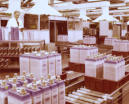


















The History of Alcad in
Redditch 1918 - 1993
The Nickel-Cadmium Battery
In 1899, Waldemar Jungner of Sweden created the first nickel-cadmium battery. At this time, the only direct competitor was the lead acid battery. The nickel-cadmium battery offered several advantages in certain applications. Early nickel-cadmium batteries were physically and chemically robust and, early modifications to the design increased the energy density to about half of that of primary batteries, significantly better than lead acid batteries. The nickel-cadmium battery (commonly abbreviated NiCd battery) is a rechargeable system which uses active chemicals based on nickel (Ni) and cadmium (Cd). Through its electrochemistry, the nickel cadmium battery has a stable behaviour giving it a long life, good electrical and mechanical characteristics and a resistance against abusive conditions. Another historically important modification to the basic nickel-cadmium cell was the addition of lithium hydroxide to the potassium hydroxide electrolyte. This has the effect of prolonging the service life by making the cell more resistant to electrical abuse. In its ‘flooded’ form it is found in general industrial applications and,has a specific niche market in application areas which are difficult for other battery technologies. Due to their beneficial technical characteristics as compared to lead based technologies and good service lifetimes, they are used in standby applications such as railway lighting and security applications, start batteries for aeroplanes and critical stationary applications where a high level of security is required.Principles
The traditional design for the plates used in industrial nickel-cadmium batteries is the pocket construction. The active material, either in powder form or compressed briquettes, are enclosed in perforated pockets produced from nickel plated steel foil. This acts both as a mechanical support for the briquette and as a current collector. Several pockets are then crimped or welded into a steel frame to form a rectangular plate. The active materials used in nickel-cadmium cells are produced in the discharged form. These are nickel or cadmium hydroxide for the positive and negative plate respectively. Vertical separating rods or bars made from polystyrene or polypropylene are used to prevent contact between adjacent positive and negative plates in the stack. In some low maintenance products this type of separation is replaced by a fibrous polyamide separator which is used to enhance the recombination level and reduce water consumption. The cells are filled with an electrolyte of 1.20 sg to 1.33 sg potassium hydroxide solution (KOH). The completed stack of nickel cadmium battery plates is fitted into containers made either of steel ot plastic. Electro-chemistry As the cell is discharged the active materials consume water (H2O) and become transformed to nickel hydroxide (Ni(OH)2) and cadmium hydroxide (Cd(OH)2) according to the following equation representing the overall electrochemical reaction occurring in the battery cell: 2 NiOOH + Cd + 2 H2O = 2 Ni(OH)2 + Cd(OH)2 This reaction goes from left to right when the battery is being discharged and from right to left when it is being recharged. The alkaline electrolyte (commonly KOH) is not consumed in this reaction.
Alcad History is part of my Explore Redditch group of websites Designed, maintained and administered by Anthony Green























The History of Alcad
in Redditch
1918 - 1993
The Nickel-Cadmium Battery
In 1899, Waldemar Jungner of Sweden created the first nickel-cadmium battery. At this time, the only direct competitor was the lead acid battery. The nickel-cadmium battery offered several advantages in certain applications. Early nickel- cadmium batteries were physically and chemically robust and, early modifications to the design increased the energy density to about half of that of primary batteries, significantly better than lead acid batteries. The nickel-cadmium battery (commonly abbreviated NiCd battery) is a rechargeable system which uses active chemicals based on nickel (Ni) and cadmium (Cd). Through its electrochemistry, the nickel cadmium battery has a stable behaviour giving it a long life, good electrical and mechanical characteristics and a resistance against abusive conditions. Another historically important modification to the basic nickel-cadmium cell was the addition of lithium hydroxide to the potassium hydroxide electrolyte. This has the effect of prolonging the service life by making the cell more resistant to electrical abuse. In its ‘flooded’ form it is found in general industrial applications and,has a specific niche market in application areas which are difficult for other battery technologies. Due to their beneficial technical characteristics as compared to lead based technologies and good service lifetimes, they are used in standby applications such as railway lighting and security applications, start batteries for aeroplanes and critical stationary applications where a high level of security is required.Principles
The traditional design for the plates used in industrial nickel-cadmium batteries is the pocket construction. The active material, either in powder form or compressed briquettes, are enclosed in perforated pockets produced from nickel plated steel foil. This acts both as a mechanical support for the briquette and as a current collector. Several pockets are then crimped or welded into a steel frame to form a rectangular plate. The active materials used in nickel-cadmium cells are produced in the discharged form. These are nickel or cadmium hydroxide for the positive and negative plate respectively. Vertical separating rods or bars made from polystyrene or polypropylene are used to prevent contact between adjacent positive and negative plates in the stack. In some low maintenance products this type of separation is replaced by a fibrous polyamide separator which is used to enhance the recombination level and reduce water consumption. The cells are filled with an electrolyte of 1.20 sg to 1.33 sg potassium hydroxide solution (KOH). The completed stack of nickel cadmium battery plates is fitted into containers made either of steel ot plastic. Electro-chemistry As the cell is discharged the active materials consume water (H2O) and become transformed to nickel hydroxide (Ni(OH)2) and cadmium hydroxide (Cd(OH)2) according to the following equation representing the overall electrochemical reaction occurring in the battery cell: 2 NiOOH + Cd + 2 H2O = 2 Ni(OH)2 + Cd(OH)2 This reaction goes from left to right when the battery is being discharged and from right to left when it is being recharged. The alkaline electrolyte (commonly KOH) is not consumed in this reaction.





















